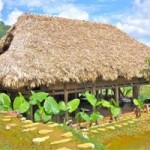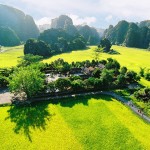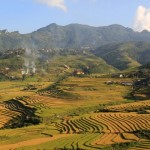How to travel on Bai Tu Long Bay
The area immediately northeast of Halong Bav is known as Bai Tu Long Bay. With long and smooth sand banks and clear water waves, Bai Tu Long Bay is associated with the graceful and sweet beauty of a teen-aged girl.
The bay also attracts a growing number of domestic and foreign visitors to its historical and cultural sites, rare and precious specialties, and the archipelago’s unspoiled beauty.
There is a legend about the archipelago that in the old days when the Vietnam was attacked by foreign invaders, the God sent a mother dragon and its babies to support the Vietnamese people. The dragons immediately blew out myriad pearls and gems that turned into grand rock mountains as a solid citadel to protect the Vietnam. After the foreign invaders were pushed away, the mother dragon and its babies did not return to the heaven but stayed in the lower world. The land where the mother dragon landed was then called Ha Long, and where the baby dragons landed called Bai Tu Long. The area where the dragon tails lashed was called Long Vi, nowadays Tra Co Peninsula, which consists of many long and smooth sand banks.
There are hundreds of islets rising from the water and many quirkily shaped rock mountains on Bai Tu Long Bay’s site. Touring Bai Tu Long Bay, a day is not enough for visitors to discover these mysterious islets. Bai Tu Long National Park can also bring great surprises, and is one of the most desirable stopovers for visitors making a trip to Bai Tu Long Bay.
The Bai Tu Long National Park was formerly the 20km long and 1.5km wide Ba Mun Island. That island is part of Van Don District, some 60km away from Bai Chay Beach. The long island serves as a solid breakwater, preserving peaceful life for the whole region. The island is in fact a thick primitive forest consisting of two vegetation layers. The primeval layer consists of rare and precious woods like ironwood, teakwood, and canary-wood, while the second layer includes valuable herbs like araliaceous bark and rhubarb plant.
The Ba Mun primitive forest is the habitat of a variety of fauna. Spotted deer with their smooth fur are the most famous species. After showers when the weather turns fine, spotted deer often go to the forest edge to pick fresh buds that were washed by rainwater. The view from afar is excellent.
Visitors can reach the Bai Tu Long National Park by road from Bai Chay Beach or more romantically by speedboat. After tours, visitors can relax at stilt-houses near the water offering a wide range of food and drink.
Visitors can also call on a fishing village at Minh Chau Island or drop in on Cai Lang, the oldest village in the island with its clear-water Nang Tien (Fairy) Well. People once said that the girls’ hair would grow longer and blacker if they used water from the well to wash it.
Taking advantage of Bai Tu Long Bay’s attractions, many domestic travel companies both at home and abroad offer tours to the site. One of the best-selling tours brings visitors to the Bai Tu Long National Park, a fishing village at Minh Chau Island, Cai Lang, Thong Thien Cave, Phat Co Island, and finally returns to the shore to call at Cua Ong Temple and Van Hoa Port. Visitors can also go through thick forests to reach the habitat of ethnic minority groups (Dao Do, Tay, and San Diu minorities) and enjoy authentic local dishes.
Bai Tu Long Bay is every bit as beautiful as its famous neighbour. Indeed, in some ways it’s more beautiful, since it has scarcely seen any tourist development. This has its positives and negatives. The bay is unpolluted and undeveloped, but there’s little tourism infrastructure. It’s pretty hard travelling around and staying here, and unless you speak Vietnamese, it’s difficult to get information.
Charter boats can be arranged to Bai Tu Long Bay from Halong Bay; a boat suitable for 20 passengers costs US$10 per hour and the one-way journey takes about five hours. A cheaper alternative is to travel overland to Cua Ong pier, catch a public ferry to Van Don Island and visit the remote outlying islands by boat from Cai Rong pier.








